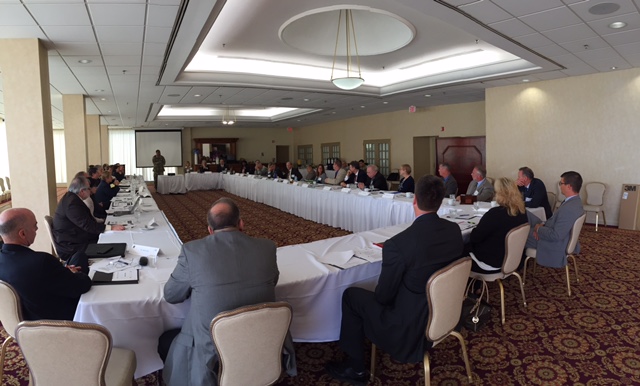
By Tara Clements
FORT BELVOIR, Va. (Sept. 14, 2015) – More than 30 Army acquisition career development leaders representing 24 agencies and all 14 acquisition career fields met Sept. 9 to discuss key issues affecting the Army Acquisition Workforce (AAW) and share best practices.
Attendees from across the 37,000-strong AAW represented the acquisition career fields, from contracting to small business to engineering, known as Army Acquisition Functional Advisors, or AAFAs; as well as key career advocates within major command and organizations, known as Acquisition Career Management Advocates, or ACMAs.
“This community of practice is here today to help communicate with the workforce,” said Craig Spisak, director of the U.S. Army Acquisition Support Center (USAASC) and deputy director for Acquisition Career Management (DACM).
This was the first event of its kind in years, primarily due to funding constraints.

More than 30 Army acquisition career development leaders representing 24 agencies and all 14 acquisition career fields met at a summit hosted by the Army DACM office at Fort Belvoir earlier this week to discuss key issues affecting the Army Acquisition Workforce. Mr. Thomas Bagwell, ACMA at PEO Ground Combat Systems ACMA speaks with Diane Murtha, concept and policy development chief at the Army DACM Office. Photos by Tara Clements, Communications Outreach.
“This was great—and there’s been a lot of great information,” said Traci Jones, deputy chief of staff and ACMA for the Program Executive Office for Simulation, Training and Instrumentation.
Others echoed this sentiment and discussed how valuable this opportunity was in bringing the two groups of leaders together with the Army DACM Office at one time and in one location to share career development perspectives as well as challenges.
“The reality is for us to arm, feed, clothe, transport and protect Soldiers, and it takes talented people from many career fields to make that happen.”
Topics covered at the day-long session included an overview of the Army DACM Office, roles and responsibilities of ACMAs and AAFAs, and Better Buying Power as well as several talent management initiatives including key leader positions, mentoring, the upcoming expanded use of the senior rater potential evaluation, workforce certification compliance, and the health of the ACFs within the AAW.
Lt. Gen. Michael E. Williamson, the Army DACM, stopped by for some one-on-one time with the group, emphasizing the importance of their roles, most of which are appointed by each organization or functional area and considered an additional responsibility.

From the left: Mr. Larry Leiby, Test and Evaluation functional advisor; Lt. Gen. Michael E. Williamson, Army DACM; Mr. Scott Davis, PEO Combat Support & Combat Service Support ACMA.
“I appreciate the roles that you’ve taken on and the investment you’re making in the workforce. I know this is not the only thing you’re responsible for, but it’s very important,” he said.
Williamson went on to note the importance of identifying and nurturing talent early on to grow the workforce—not next year, but in five to 10 years from now.
“For me, it’s about capacity and capability … it’s not about things,” he added. “The reality is for us to arm, feed, clothe, transport and protect Soldiers, and it takes talented people from many career fields to make that happen.”
Williamson closed his comments by highlighting the need to be more efficient among the community with respect to sharing information. “You and your workforce work hard and put in lots of hours, but I think we can be more efficient,” he said.

Craig Spisak, USAASC director and deputy DACM, Kathleen Leonard, functional advisor, Diane Bullis, Program Executive Office Assembled Chemical Weapons Alternatives, and Marion Whicker, ACMA for U.S. Army Tank-Automotive and Armaments Command discuss workforce issues during a break.
As the day progressed, one of the areas of discussion focused on the need for providing feedback to workforce members. Most of the career development opportunities require extensive application packets, but a lack of feedback on why an applicant wasn’t chosen for a particular opportunity often prevents workforce members from applying for other positions in the future.
“There’s a great hesitancy across the DOD community to provide critical feedback to applicants, even at the supervisor level,” said Spisak, noting that where most applicants falter is not being able to articulate in writing the situations in which key skills and abilities were demonstrated in a position—doing more than simply citing a previously held position.
A portion of the summit also focused on the Army DACM Office and its new organizational structure, which was rolled out this spring.
Under the new structure, the Army DACM Office is task-organized in three divisions to better support the workforce: Human Capital Initiatives is DOD-focused; Proponency and Leader Development is Army-focused; and Workforce Support is focused on the individual workforce member.
“Our aim is to support the workforce by being their one-stop shop for everything acquisition-career- related,” said Joan Sable, chief of the Human Capital Initiatives division.
Army AL&T News is the premier online news source for the Army Acquisition Workforce. Click to Subscribe.







